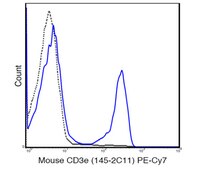MABF1581 Sigma-AldrichAnti-CD3e (Mouse), PE-Cy7, clone 145-2C11 Antibody
This armenian hamster monoclonal Anti-CD3e Antibody (Mouse), PE-Cy7, clone 145-2C11, Cat. No. MABF1582 is validated for use in Flow Cytometry, for the detection of CD3e.
More>> This armenian hamster monoclonal Anti-CD3e Antibody (Mouse), PE-Cy7, clone 145-2C11, Cat. No. MABF1582 is validated for use in Flow Cytometry, for the detection of CD3e. Less<<Recommended Products
Overview
| Replacement Information |
|---|
Key Spec Table
| Species Reactivity | Key Applications | Host | Format | Antibody Type |
|---|---|---|---|---|
| M | FC | AHm | PE-Cy7 | Monoclonal Antibody |
| References |
|---|
| Product Information | |
|---|---|
| Format | PE-Cy7 |
| Presentation | Purified Armenian Hamster monoclonal containing 10 mM NaH2PO4, 150 mM NaCl, 0.09% NaN3, 0.1% gelatin, pH7.2. |
| Quality Level | MQ100 |
| Physicochemical Information |
|---|
| Dimensions |
|---|
| Materials Information |
|---|
| Toxicological Information |
|---|
| Safety Information according to GHS |
|---|
| Safety Information |
|---|
| Packaging Information | |
|---|---|
| Material Size | 25 μg |
| Transport Information |
|---|
| Supplemental Information |
|---|
| Specifications |
|---|
| Global Trade Item Number | |
|---|---|
| Catalogue Number | GTIN |
| MABF1581 | 04055977293456 |
Documentation
Anti-CD3e (Mouse), PE-Cy7, clone 145-2C11 Antibody SDS
| Title |
|---|
Anti-CD3e (Mouse), PE-Cy7, clone 145-2C11 Antibody Certificates of Analysis
| Title | Lot Number |
|---|---|
| Anti-CD3e (Mouse), PE-Cy7, -QVP1504287 | QVP1504287 |
| Anti-CD3e (Mouse), PE-Cy7, clone 145-2C11 - VP2111118 | VP2111118 |
| Anti-CD3e (Mouse), PE-Cy7, clone 145-2C11 - VP2308113 | VP2308113 |
Brochure
| Title |
|---|
| New Products Flyer- Vol 4 Signaling Feature- NEW! Phosphohistidine Antibody |
Posters
| Title |
|---|
| Post-Translational Modifications |












